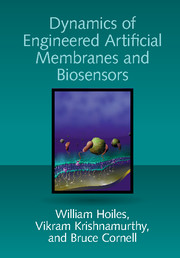Book contents
- Frontmatter
- Contents
- Preface
- List of Abbreviations
- Part I Introduction and Background
- Part II Building Engineered Membranes, Devices, and Experimental Results
- 4 Formation of Engineered Tethered Membranes
- 5 Ion-Channel Switch (ICS) Biosensor
- 6 Physiochemical Membrane Platforms
- 7 Experimental Measurement Methods for Engineered Membranes
- Part III Dynamic Models for Artificial Membranes: From Atoms to Device
- Appendices
- Bibliography
- Index
5 - Ion-Channel Switch (ICS) Biosensor
from Part II - Building Engineered Membranes, Devices, and Experimental Results
Published online by Cambridge University Press: 25 May 2018
- Frontmatter
- Contents
- Preface
- List of Abbreviations
- Part I Introduction and Background
- Part II Building Engineered Membranes, Devices, and Experimental Results
- 4 Formation of Engineered Tethered Membranes
- 5 Ion-Channel Switch (ICS) Biosensor
- 6 Physiochemical Membrane Platforms
- 7 Experimental Measurement Methods for Engineered Membranes
- Part III Dynamic Models for Artificial Membranes: From Atoms to Device
- Appendices
- Bibliography
- Index
Summary
Introduction
In this chapter we describe the ion-channel switch (ICS) biosensor. By a biosensor, we mean a sensor built out of synthetic biological material – in our case, built out of an artificial membrane, ion channels, spacers, and tethers. The purpose of the biosensor is to detect the presence of analyte molecules.
The ICS biosensor provides an example of how devices built out of tethered engineered membranes can be used for high-resolution detection of specific target (analyte) molecules. When it senses the presence of analyte molecules, the ICS biosensor responds by changing its electrical impedance significantly. The amount the impedance changes by depends on the concentration of the analyte molecules. Therefore, by examining the current flowing through the biosensor, one can detect both the presence of the analyte and its concentration. A key feature of the ICS biosensor is that the detection is performed by measuring the time-dependent conduction of the engineered membrane, which is dependent on the ensemble of aqueous pores and a single pair of conducting gramicidin (gA) dimers present. A gramicidin dimer [83, 84, 466] is an example of a conducting ion channel which allows ions to pass through the tethered membrane. Using specific molecular components and excitation potentials, the ICS can be designed to detect specific analyte molecules of interest.
The ICS biosensor provides an interesting example of engineering at the nanoscale. It is remarkable that the functionality of the device depends on approximately 100 lipids, and a pair of ion channels modulating the flow of billions of ions in a typical sensing event of approximately 5 min. Since the gramicidin monomers (each with a conducting pore of diameter 0.4 nm and length 2.8 nm) move randomly in the outer lipid leaflet of the membrane (1.4 nm thick), we can view the biosensor as a fully functioning nanomachine with moving parts. Indeed, each individual gramicidin monomer diffuses randomly over an area of order 1 μm2. Furthermore, the 4-nm-thick lipid bilayer is tethered 2–3 nm away from the gold surface by hydrophilic spacers, thereby allowing ions to diffuse between the membrane and gold. This permits a flux in excess of 106 ions per second to traverse each gramicidin channel comprised of two gA monomers.
- Type
- Chapter
- Information
- Dynamics of Engineered Artificial Membranes and Biosensors , pp. 83 - 102Publisher: Cambridge University PressPrint publication year: 2018
- 1
- Cited by



